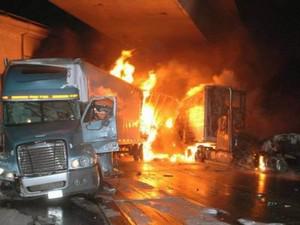Search & rescueBasic safety measures will save lives in tunnels
What has to happen to facilitate more effective rescues from tunnel fires? Researchers have been investigating how eighty research subjects wearing VR glasses reacted in a virtual tunnel fire. Their conclusion is that basic measures can save lives.

People caught in a tunnel fire tend to be paralyzed in fear // Source: flickr.com
What has to happen to facilitate more effective rescues from tunnel fires? Researchers have been investigating how eighty research subjects wearing VR glasses reacted in a virtual tunnel fire. Their conclusion is that basic measures can save lives.
“A cloud of smoke rushed towards me at tremendous speed”, says SINTEF researcher Gunnar Jenssen. “It took only a few seconds for the smoke to form a black carpet around my ankles. Then everything went black. Being trapped in a tunnel fire is a nightmare. It’s so frightening that most people become paralysed and unable to act”, he says.
To put you at ease, this terrible experience happened during a demonstration of the research methodology being applied as part of the project “Tunnel Evacuation” (Evakuering i tunnel) being carried out by SINTEF and the Norwegian Public Roads Agency (NPRA).
“There are two common reactions – fight or flight”, says Jenssen.
According to the Norwegian Accident Investigation Board, more than half of those caught in the Gudvanga tunnel fire in 2013 chose to remain in their cars rather than try to escape. This indicates that better evacuation and rescue aids are essential if lives are to be saved.
>During the last seven years we’ve experienced six major and serious tunnel fires in Norway, without any loss of life”, says Jenssen. “But this is down to pure luck, and luck is often a factor when we talk about tunnel safety”, he says.
Virtual Reality research
Using software with near-reality graphics, VR glasses and a platform that records people’s movements, researchers from SINTEF and Lund University have together tested 80 subjects as part of a virtual, but rather credible, fire exercise.
“Our work has included recreating realistic visibility conditions in black smoke”, says Jenssen. “This has never been done before. Using black smoke is important because it enables us to address issues related to visibility, and identify what we need to help people trapped in fires of this kind, who can hardly see their hands in front of their faces”, he explains.
The results have provided us with knowledge about how we behave during tunnel fires, and how we respond when we try to get to safety.
